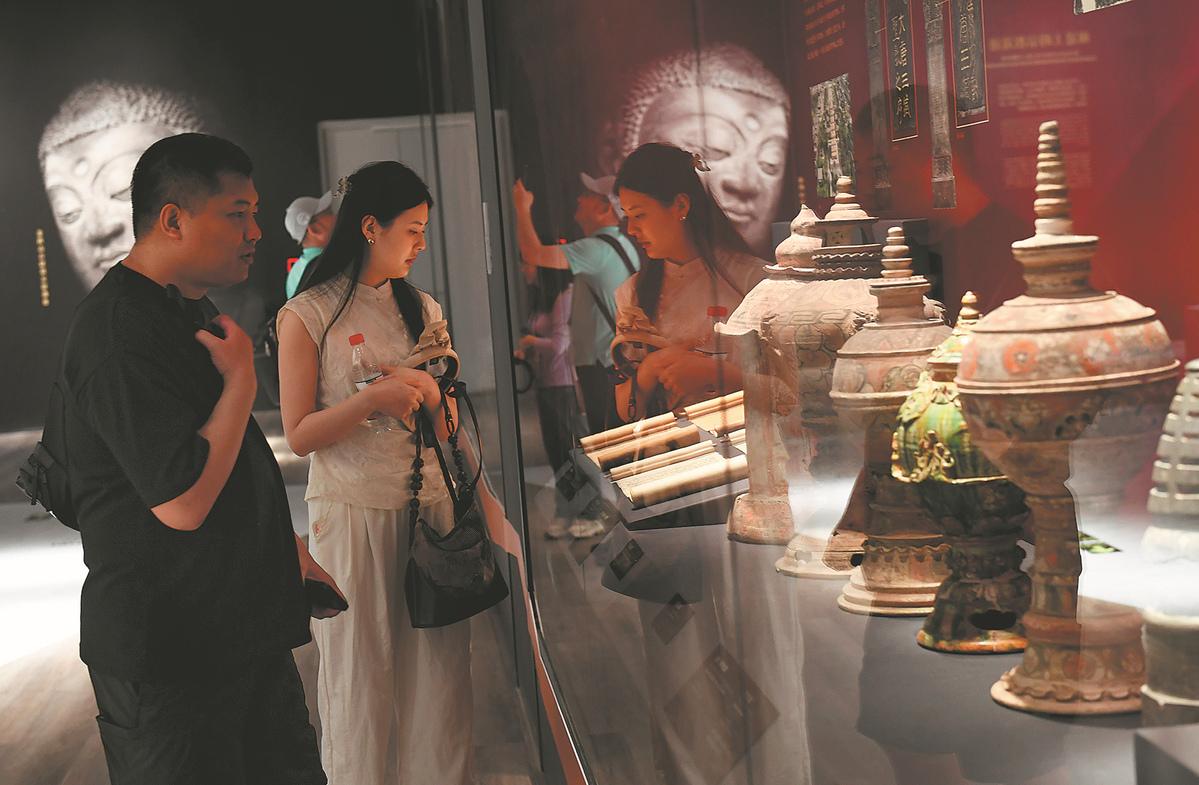
 0 Comment(s)
0 Comment(s) Print
Print E-mail China Daily, July 3, 2024
E-mail China Daily, July 3, 2024

Visitors admire cultural relics displayed at an exhibition at Shaanxi History Museum in Xi'an, Shaanxi province, in May. The exhibition, featuring cultural relics from China, Kazakhstan and Kyrgyzstan and marking the 10th anniversary of a section of the ancient Silk Road's UNESCO World Heritage status, will run through Nov 18. [Li Yibo/Xinhua]
Amid the 10th anniversary celebrations of an ancient Silk Road trade corridor's UNESCO World Heritage status last month, an ongoing exhibition in Northwest China's Shaanxi province has unveiled the remarkable conservation efforts at several sites along the historical route.
In January 2013, China and two of its Central Asian neighbors, Kazakhstan and Kyrgyzstan, jointly applied for the prestigious status for an 8,700-kilometer stretch of ancient road extending from Chang'an in what is now Xi'an, the capital of Shaanxi, to the heart of Central Asia.
UNESCO included the "Silk Roads: the Routes Network of Chang'an-Tianshan Corridor" on its World Heritage List in June 2014. The current exhibition at the Shaanxi History Museum's Qin-Han Hall marks a decade since that proud moment.
Yue Minjing, curator of the exhibition, which started on May 18 and runs through Nov 18, said the corridor highlights 33 representative sites in the three countries, and the communication and exchanges among them from the 2nd century BC to the 16th century.
On display are more than 330 artifacts from archaeological sites and museums in China and Kazakhstan, she said, noting that these exhibits give a fair idea of ancient city layouts, religious beliefs, commercial trade and artistic pursuits along the Silk Road.
Many of the exhibits bear an eloquent testimony to the cultural exchanges that took place along the route, Yue said.
For example, a bowl with linked-pearl patterns from the Talgar Site in Kazakhstan, dating back to the 13th or 14th century, is on display. Similar patterns have been found on many Tang Dynasty (618-907) gold and silver ware unearthed in China, she said.
"The pattern was commonly seen in West Asia. Considering that ancient Chinese people had to pass through Central Asia to reach West Asia, it also reflects the cultural exchanges along the ancient Silk Road," she added.
Among the artifacts on display are some Tang Dynasty pagoda-style jars, which indicate the spread of Buddhism in China. These have been mostly brought out from the storehouse of the Shaanxi History Museum, with many of these on public display for the first time.
"Such jars are common in high-level Tang tombs. Pagodas were originally used in India to hold the sarira (crystalline traces purportedly found in the cremated ashes of Buddhist spiritual masters), but when Buddhism spread to China, the ancient Chinese followed the tradition of burial, not cremation.
"As a result, they made burial objects shaped like pagodas and placed these next to coffins in a symbolic gesture, showing the influence of Buddhism on China's funerary customs," Yue said.
The 33 sites along the heritage route are classified into five categories — central towns, relics of transportation and defense, trade settlements, religious buildings, and a tomb of Han Dynasty (206 BC-AD 220) imperial envoy Zhang Qian in Hanzhong, Shaanxi.
Around 139 BC, Emperor Wudi (156-87 BC) of the Han Dynasty sent a convoy headed by Zhang on a westward journey, which eventually took them to Central Asia. This is believed to be a symbolic event in the opening of the Silk Road, Yue said.
A replica of a mural from the Mogao Grottoes in Dunhuang, Gansu province, is also on display at the exhibition. It depicts Zhang's journey and shows the influence of the event, she said.
"Zhang's opening of the road in the 2nd century BC demonstrates Chinese people's eagerness for communication with the outside. His efforts effectively introduced the Qin (221-206 BC) and Han dynasties to Central Asian and even Western countries of that time," Yue said.
"Even today, we maintain an open-minded attitude and a desire for communication with others. This mindset transcends both time and space," she added.
Hou Ningbin, director of the Shaanxi History Museum, said the prestigious World Heritage status could promote the protection of cultural heritage items and sites.
Since 2014, when the joint application was approved, various efforts have been made for achieving more archaeological discoveries, protecting cultural relics, and raising awareness about the ancient sites through educational activities, Hou said.
"Chinese archaeologists have also brought their expertise to Central and West Asia to assist in the protection of such sites over the past decade," he added.